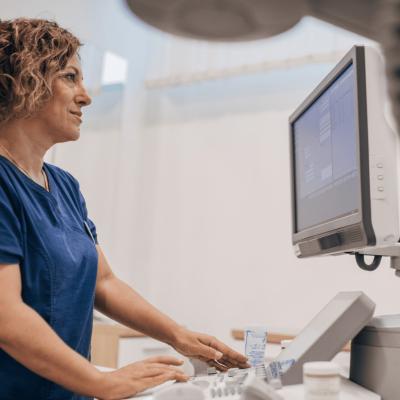- AdventHealth University

Radiology and radiography are two important health care professions that involve the use of imaging techniques to diagnose and treat diseases. Although they may appear similar, there are distinct differences between the two.
What is Radiology?
Radiology is a medical specialty that involves the use of medical imaging techniques to diagnose and treat diseases. Radiologists are medical doctors who specialize in interpreting medical images, such as X-rays, CT scans, MRI scans, ultrasound, and nuclear medicine scans. They are responsible for interpreting the images, providing diagnostic reports, and working closely with other health care professionals to guide patient care.
What is Radiography?
Radiography refers to the specific technique of capturing images using X-rays. It is a diagnostic imaging technique that uses X-ray beams to create images of the internal structures of the body. Radiographers, also known as radiologic technologists or X-ray technologists, are health care professionals trained in operating X-ray machines and positioning patients to obtain high-quality images. They work under the supervision of radiologists or other physicians and are responsible for obtaining the necessary images requested by the referring physician.
Differences Between Radiology and Radiography
In summary, radiology is the medical specialty that encompasses the interpretation and analysis of medical images, while radiography refers to the technical process of capturing images using X-ray technology. Radiologists are medical doctors who specialize in radiology and interpret a wide range of medical images, while radiographers are health care professionals who perform the actual imaging procedures, often focusing on X-ray techniques.
Education and Job Responsibilities
The distinctions between radiology (radiologists) and radiography (radiographers) are mainly due to two key factors. Namely, education and day-to-day job responsibilities.
Radiologist
Education
To become a radiologist, you must first complete a four-year undergraduate degree, followed by four years of medical school. After medical school, you must complete a residency program in radiology, which typically takes four years. During the residency program, you will receive hands-on training in imaging techniques and gain experience interpreting images. After completing the residency program, you may also choose to complete a fellowship program in a specific area of radiology, such as interventional radiology. Radiologists must also obtain a license for each state in which they practice.
Job Responsibilities
A radiologist is a medical doctor who specializes in diagnosing and treating diseases and injuries using medical imaging techniques. They are responsible for interpreting and analyzing medical images such as X-rays, CT scans, MRIs, ultrasounds, and nuclear medicine scans. Day-to-day job duties of a radiologist may include:
- Interpreting medical images such as X-rays, CT scans, and MRIs to diagnose diseases and injuries.
- Performing vital functions during exams such as fluoroscopy and biopsies.
- Generating detailed reports based on image interpretations to guide patient treatment plans.
- Collaborating with other health care professionals to provide consultations and insights on patient cases.
- Ensuring radiation safety and optimize imaging techniques to minimize radiation exposure while maintaining diagnostic quality.
Radiographer
Education
To become a radiographer, you must complete an accredited radiography program. These programs typically take two years to complete, leading to an associate degree. Radiography programs may include coursework in anatomy and physiology, radiobiology, medical imaging physics, and patient care. In addition to classroom instruction, radiography programs include hands-on imaging techniques training. After completing a radiography program, you must also obtain licensure in the state where you plan to work.
Job Responsibilities
Day-to-day job duties of a radiographer may include:
- Operating imaging equipment, such as X-ray machines, CT scanners, and MRI scanners, to capture medical images of patients.
- Positioning patients correctly and ensuring their comfort and safety during imaging procedures.
- Following established protocols and guidelines to obtain high-quality images for accurate diagnosis.
- Assisting radiologists and other healthcare professionals in performing specialized imaging procedures.
- Maintaining and troubleshooting imaging equipment to ensure proper functioning.
How to Become a Radiographer or Radiologist
In short, radiography is the process of creating images, while radiology is the field that uses those images to diagnose and treat diseases. Radiologists, radiographers, and other imaging professionals are all part of a care team that plays a significant role in patient care. If you are interested in a career in radiography, AdventHealth University offers an Associate of Science in Radiography program as well as our Bachelor of Science in Nuclear Medicine Technology program.
Recommended Readings
Benefits of Interventional Radiology
Nine Key Figures in Radiology
How to Become A Radiology Director
Sources
Radiologic and MRI Technologists." Bureau of Labor Statistics, U.S. Department of Labor


